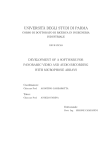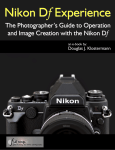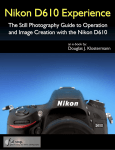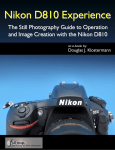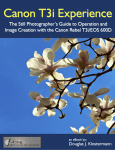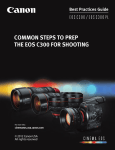Download Canon EOS REBEL T5I Specifications
Transcript
Canon T5i / 700D Experience PREVIEW of: Canon T5i / 700D Experience The Still Photography Guide to Operation and Image Creation with the Canon Rebel T5i / EOS 700D by Douglas J. Klostermann Full Stop. good writing for better photography 1 Canon T5i / 700D Experience All rights reserved. This e-book is licensed for your personal enjoyment only and may not be re-sold, fileshared, or given away. No part of this book may be reproduced or transmitted in any form or by any means, electronically or in print, without expressed permission from the author. Every effort has been made to make this e-book as accurate as possible, but no warranty of fitness is implied. The information is provided on an as-is basis. The author shall have no liability or responsibility with respect to any loss or damages arising from the information provided in this e-book including but not limited to the use of any of the materials or methods described, the products, retailers, Internet web sites, or links provided. Please read and follow all instructions and use, safety and handling precautions expressed in the manuals provided with your equipment and software, and which take precedence over any content in this work. All contents of this work including cover design, text, and photographs, with the exception of products, brands, software, contents of menus and screenshots, and logos, are copyright by the author. All products, brands, software, contents of menus and screenshots, and logos are property of the respective companies and websites. Terms which are trademarks or service marks in this e-book are used in an editorial and/ or educational manner, and should not be regarded as affecting the validity of any trademark or service mark. “Canon” is a trademark of Canon Inc. “Adobe,” “Photoshop,” and “Lightroom” are trademarks of Adobe Systems Inc. The author and the contents of this book are not affiliated with or endorsed by Canon Inc. Special thanks to LensProToGo www.lensprotogo.com Douglas Klostermann is a participant in the Amazon Services LLC Associates Program, an affiliate advertising program designed to provide a means for sites to earn advertising fees by advertising and linking to amazon.com. Copyright 2013 Douglas J. Klostermann Cover design and photograph by the author. Canon T5i / 700D Experience - PREVIEW The Still Photography Guide to Operation and Image Creation with the Canon Rebel T5i / EOS 700D by: Douglas J. Klostermann Version 1.0 May 2013 Author’s website: www.dojoklo.com Author’s blog: http://blog.dojoklo.com/ Published by Full Stop Media. good writing for better photography Cambridge, Massachusetts USA http://www.dojoklo.com/Full_Stop/ 2 Canon T5i / 700D Experience CONTENTS 1. INTRODUCTION............................................................................................... 5 1.1 Take Control of Your Camera ................................................................................. 6 1.2 Using This Guide ..................................................................................................... 8 1.3 Getting Started ...................................................................................................... 10 2. CAMERA CONTROLS ................................................................................... 13 2.1 T5i / 700D Camera Body ....................................................................................... 13 2.2 Quick Control Screen and Touch Screen.............................................................. 19 3. MENUS and CUSTOM FUNCTIONS ............................................................. 22 3.1 Introduction to Setting Up the T5i / 700D .............................................................. 22 3.2 Shooting Menus..................................................................................................... 23 3.3 Live View Shooting menu...................................................................................... 35 3.4 Playback Menus .................................................................................................... 40 3.5 Set-Up Menus........................................................................................................ 47 3.6 My Menu ................................................................................................................ 57 3.7 Movie Shooting Mode Menus................................................................................ 58 3.8 Custom Functions (C.Fn) Menus .......................................................................... 64 4. PLAYBACK and IMAGE FILE FORMATS .................................................... 70 4.1 Playback ................................................................................................................ 70 4.2 Image File Formats - JPEG vs. RAW.................................................................... 71 4.3 File Sizes and Maximum Burst Rate ..................................................................... 73 5. AUTOFOCUSING ........................................................................................... 75 5.1 Introduction to Autofocus....................................................................................... 75 5.2 Viewfinder Autofocus............................................................................................. 76 5.3 Focus Modes ......................................................................................................... 79 5.4 Live View and Movie Autofocus Methods ............................................................. 86 5.5 Back Button Focusing............................................................................................ 91 6. DRIVE MODES ............................................................................................... 94 7. EXPOSURE Part 1 ......................................................................................... 96 7.1 Aperture, Shutter Speed and ISO ......................................................................... 96 7.2 Aperture Priority Mode (Av) and Shutter Priority Mode (Tv) ............................... 100 7.3 Full Stops............................................................................................................. 106 7.4 Manual Exposure Mode (M) ................................................................................ 108 7.5 Basic Zone Shooting Modes ............................................................................... 111 8. METERING MODES ..................................................................................... 120 8.1 Evaluative Metering ............................................................................................. 120 8.2 Partial Metering ................................................................................................... 121 8.3 Spot Metering ...................................................................................................... 123 8.4 Center-Weighted Average Metering.................................................................... 125 8.5 Manual Metering.................................................................................................. 127 8.6 Metering Modes and Exposure ........................................................................... 128 9. EXPOSURE Part 2 ....................................................................................... 130 9.1 Exposure Lock..................................................................................................... 130 3 Canon T5i / 700D Experience 9.2 Histograms........................................................................................................... 132 9.3 Exposure Compensation ..................................................................................... 135 9.4 Auto Exposure Bracketing................................................................................... 136 10. ADDITIONAL CAMERA FUNCTIONS ....................................................... 140 10.1 Highlight Tone Priority and Auto Lighting Optimizer ......................................... 140 10.2 White Balance ................................................................................................... 142 10.3 Picture Styles and Ambience Selection ............................................................ 147 10.4 Flash .................................................................................................................. 154 10.5 External Flash.................................................................................................... 160 10.6 Wireless Flash ................................................................................................... 164 10.7 Sensor Cleaning ................................................................................................ 170 10.8 Putting it All into Practice................................................................................... 170 11. THE IMAGE TAKING PROCESS ............................................................... 172 11.1 Still Subjects ...................................................................................................... 172 11.2 Moving Subjects ................................................................................................ 174 12. VIDEO - AN INTRODUCTION .................................................................... 177 13. COMPOSITION........................................................................................... 184 14. LENSES ...................................................................................................... 193 14.1 Lens Notations................................................................................................... 193 14.2 Fixed Maximum Aperture vs. Variable Maximum Aperture............................... 196 14.3 Which Lens to Buy Next .................................................................................... 197 15. PHOTOGRAPHY ACCESSORIES ............................................................. 206 15.1 Canon Rebel T5i / EOS 700D Accessories....................................................... 206 15.2 Digital SLR Photography Accessories .............................................................. 208 15.3 Digital Photography Books ................................................................................ 211 16. CONCLUSION ............................................................................................ 213 Future Updates to the Text........................................................................................ 213 About the Author........................................................................................................ 214 4 Canon T5i / 700D Experience 1. INTRODUCTION With the introduction of the Rebel T5i (also known as the EOS 700D) Canon continues its popular line of versatile, affordable, and easy to operate digital SLR cameras. On the surface, the T5i / 700D shares the appearance and many of the specifications of recent previous models: an 18 megapixel sensor to provide detailed images with accurate color, a 63-zone dual-layer exposure metering system to properly determine the correct exposure even in challenging lighting situations, and high ISO performance for obtaining clean, sharp images in low-light settings. But look a little deeper and it is revealed that the T5i / 700D also shares several other capabilities of Canon’s semi-professional models. The camera boasts a fast Digic 5 processor to allow for rapid and advanced in-camera processing of images, incorporates a 9 point, all cross-type autofocus system similar to current and previous mid-level models (60D, 5D Mk II), as well as a quick 5 frames per second (fps) maximum continuous shooting speed. These features will help you capture more sharp images and optimum moments while photographing both still and moving subjects. Plus the Digic 5 chip paired with the rapid frame rate allows for multi-shot modes that can capture and combine a burst of images, in order to obtain results with wider dynamic range or lower digital noise than a single frame can deliver. Figure 1 - Detail of the Canon T5i / 700D, shown with the Canon EF 50mm f/1.4 USM lens. 5 Canon T5i / 700D Experience Not to mention the T5i / 700D offers Touch Screen capabilities with its articulating high resolution rear LCD Monitor for easier selection of settings and menu items, multi-touch image review, and touch autofocus initiation in Live View and Movie shooting. While previous Canon dSLR models up until the recent T4i / 650D did not allow for continuous autofocusing during Movie shooting, the T5i / 700D offers the current hybrid autofocus system that enables fast, accurate, full-time autofocusing during Live View and Movie shooting. The autofocus operation is made even faster and quieter when using one of Canon’s STM “stepping motor” lenses. The T5i / 700D also has a built-in stereo microphone and stereo mic output jack, additional shooting modes, and Creative Filters that can now be previewed in Live View shooting mode before applying. And it incorporates Chromatic Aberration Correction, a lens correction feature originally introduced on the high-end Canon 5D Mark III. With all of these features and its customization options, this camera has the ability to meet or exceed most enthusiast photographers’ needs. The Canon Rebel T5i / EOS 700D is a powerful, advanced tool for digital photography and is fully capable of capturing professional quality images in most any situation you wish to use it. But it is merely a tool. It is up to you to make use of its features and capabilities to create the images you envision. While the camera’s manual will tell you about the settings and controls and how they function, this guide builds upon that to explain when and why you want to use them. Every button, menu item, Custom Function setting, and feature of the T5i / 700D is there for a reason: to help you capture and output the images you want. Some of them are more useful to different types of photographers and shooting situations and you don’t need to learn and use them all immediately, but this guide should help to give you the knowledge to confidently use the ones that turn your Canon Rebel T5i / EOS 700D into an image capturing tool that works best for you. 1.1 Take Control of Your Camera Because the T5i / 700D is a tool to take the images you want to take, you can’t always allow the camera to make decisions for you. You have to take control of the camera to ensure that you capture exactly the images you intend - by autofocusing where you want, setting the aperture or shutter speed that you want, and obtaining the exposure you want. While the T5i / 700D is an intelligent camera, it cannot read your mind and your intentions and does not know that you wish to focus on and properly expose the face of the man on the right side of the frame, while making the other man and the background appear out of focus, and the subject to be caught still and not be blurred from his motion, on this bright and sunny day (see Figure 2). You have to tell the camera to do all of this through the various controls and settings, such as the autofocus AF Mode and AF Points (focus on the face on the right), the Exposure Metering Mode (properly expose for the face and the scene), the Aperture setting (the out-of-focus second man and background), the Shutter Speed (freeze the motion of the subject), the ISO (bright day) and the White Balance (sunny day). 6 Canon T5i / 700D Experience Figure 2 - Parade, Brooklyn, NY - Autofocus, exposure metering mode, aperture, shutter speed, ISO, and white balance all considered in capturing this image. Shutter speed 1/320, aperture f/4.5, ISO 100. One has to think about all this stuff for every photo? Well, yes, that is what digital SLR photography is all about! At least if you wish to consistently create well made, interesting, and compelling images. That is why the T5i / 700D has all these controls and features for you to easily make use of, either with the camera controls or via the Quick Control Screen. You’re not in the realm of point-and-shoots anymore! Learning to use and get the most out of a versatile dSLR camera like the T5i / 700D takes time, practice, patience, mistakes, and experimentation. If you are not yet familiar with all the controls of a dSLR and the exposure concepts of digital photography, don’t expect to just pick it all up at once, in one or two readings of a single book. (In fact, you wouldn’t want to, as the never ending task of learning and mastering photography is a big part of what it’s all about!) Try not to become frustrated when you don’t quite understand something or aren’t yet getting the results you desire. Instead learn the controls, functions, settings, and concepts bit by bit, try them out in real life shooting situations and experiments, and return to this guide, the Canon manual, and other photography books to address questions and problems you encounter. Continue to learn and to photograph often and it should all begin to come together, sometimes slowly and sometimes in rapid bursts of discovery and understanding. If you have upgraded from an older Canon dSLR to the T5i / 700D, you should find that many of the basic controls and features are similar. And its additional features and 7 Canon T5i / 700D Experience capabilities will more easily help you to capture photographs that you may have been limited in consistently obtaining before. If you are new to dSLR photography, this book will help guide you through the camera’s features, controls, and capabilities. Be sure to take it slowly and patiently and start with the basic features and concepts that I will explain. With practice and experience you will soon be shooting with confidence and can begin to take advantage of the camera’s more advanced functions. 1.2 Using This Guide There are many different ways to use a digital SLR camera and its controls to capture images, and many diverse situations in which photographers work. I’m going to concentrate on the techniques that I believe are the most practical, useful, and effective for the majority of intermediate and dedicated photographers. The settings and controls I discuss can apply to various types of photography including everyday general photography, action, travel, and studio photography. Once you have a firm grasp of the controls, settings, and basic techniques you will have the tools and knowledge to address different issues and challenging situations, and I encourage you to experiment and continue to learn. Since this guide is intended to help you get the most out of your T5i / 700D, it will not go into detail about all of the automatic features. (For simplicity, I am typically going to refer to the camera as the “T5i” from this point forward - my apologies to the readers whose camera badge reads “700D”!) The Canon T5i is a sophisticated tool that deserves to be used to its full potential, and that involves taking control of the camera and its functions, which means taking it off Auto+, off Program, off automatically selected auto-focus points when not required, off Auto ISO. While this may be more challenging at first, these are the techniques that are necessary to take full advantage of the capabilities of any dSLR including the T5i, and will lead you to having more control and consistency over your image making. Hopefully this will inevitably lead to better images! This guide is intended to be used with the camera in your hands. That is the best way to directly follow and understand the controls, functions, menus, and settings as they are being explained. It is also intended to be used in addition to the camera’s manual, not to completely replace it, so every bit of information in the Canon EOS Rebel T5i / EOS 700D Instruction Manual will not be repeated here. Among the official manual’s often brief descriptions and sometimes frustratingly incomplete or disjointed explanations there is some valuable information, as well as the basics for buttons, controls, and how to change all the settings. And I will refer you to the manual for extremely specialized or rarely accessed features that are explained well. Note that the T5i manual can also be obtained as a PDF file from the T5i product page on the Canon website, under Brochures and Manuals: http://www.usa.canon.com/cusa/consumer/products/cameras/slr_cameras/eos_rebel_t5 i_18_55mm_is_stm_kit#BrochuresAndManuals As you can see, there is a lot to make sense of regarding terminology and controls, so I recommend that you familiarize yourself with the controls and displays of the camera 8 Canon T5i / 700D Experience body, as described in this guide in Chapter 2 Camera Controls (and shown on pages 20-24 of the Canon EOS Rebel T5i / EOS 700D Instruction Manual), as well as read through the manual at some point and attempt to understand as much as possible. Yes, some of it may be complicated and confusing at first, but this guide will explain and clarify the numerous buttons, controls, menus, and settings and explain how you may wish to set them and when and why you will want to use them in your photography. Various settings of the T5i can be controlled in multiple ways using the menus, buttons, Cross Keys, and the [Q] Button and Quick Control Screen. Settings can be selected and viewed on the Quick Control screen by using either the camera controls or the Touch Screen, or viewed in the Viewfinder and changed with the camera controls without removing your eye from the scene. Explore the different options and find the ways that work most quickly and intuitively for you and the situations you are shooting. Figure 3 - Detail of the Canon T5i / 700D. Any time I capitalize something in this text it is a proper term that can be looked up in the Canon EOS Rebel T5i / EOS 700D Instruction Manual. I will capitalize the names of actual buttons, controls, camera parts, and menu items, such as Erase Button, Main Dial, Cross Keys, and Metering Mode. Words and phrases that are capitalized and bold refer to chapters and sections within this guide. Turn on or access the bookmarks navigation or contents panel in your PDF / EPUB viewer or e-reader to quickly navigate to different sections - though I suggest reading straight through this guide, in order, the first time. 9 Canon T5i / 700D Experience 3. MENUS and CUSTOM FUNCTIONS 3.1 Introduction to Setting Up the T5i / 700D The Menus and Custom Functions of Canon dSLR cameras allow you to have greater, more precise control over how your camera operates. They are part of what makes the T5i a more powerful tool than a digital compact or basic entry-level dSLR, and they enable you to customize the camera to work for you, to work how you work. I highly recommend that you dig into these menus and change the settings to the options that allow you to use the camera in the manner that works best for you and your way of photographing. Some of the Menu items are only used when shooting, reviewing, or processing images, but many of them should be set up in advance. Below are explanations and recommendations for the Menus and the Custom Functions of the Canon T5i / 700D. Please note that this guide will go into further detail about most of these settings and functions later in the detailed chapters and sections about Autofocusing, Exposure, White Balance, etc. Although I have attempted to explain many of these items in a more understandable and unified way than the manual, you still may need to first read through this chapter to learn about related Menu and Custom Function settings, plus read the applicable sections of this guide, and then work with the camera a bit before you will completely understand a specific item and how you may wish to set it. So don’t become overwhelmed if you don’t yet understand the settings or terminology used to describe the Menu and Custom Function settings and their options. And if you don’t yet understand some of the settings or why you might wish to change them, leave those on the default or recommended settings for now. Remember to return to them later after you have completed the guide, worked with your camera, begun to better understand its controls and functions, and started to determine exactly how you want to work. Important Note: As with most current dSLR cameras, the T5i has a couple menu settings “quirks” or conflicts that may drive you crazy if you are not aware why they are occurring. Most notably, some settings will be inaccessible in the menus and you will not be able to select them if a “conflicting” setting is enabled. Examples include certain functions like Multi-Shot Noise Reduction, Handheld Night Scene, or HDR Backlight Control which are not accessible when the camera is set to capture files in the RAW or RAW+JPEG image format. You must then set the Image Quality to one of the JPEGonly settings. The use of Auto Exposure Bracketing, White Balance Bracketing, MultiShot Noise Reduction, and/ or Long Exposure Noise Reduction will also conflict with other settings including use of the Creative Filters. These are actually not arbitrary quirks, but are typically due to logical conflicts or camera limitations. I will mention these conflicts in the applicable settings. Place your Mode Dial on Av (Aperture-Priority Auto Shooting Mode) before you go through these menu settings because they don’t all appear in the menus if your camera is in Auto+ mode, Program mode, or one of the Basic Zone modes. You may wish to 22 Canon T5i / 700D Experience first review the Camera Controls in Chapter 2 if you are not yet familiar with the T5i controls. 3.2 Shooting Menus Shooting 1 Menu Figure 13 - Shooting 1 Menu. Image Quality You are putting a lot of effort into taking your images and the T5i provides an excellent 18 MP sensor on which to record them. You should make sure the files are of the best possible quality. I will discuss JPEG vs. RAW file formats in detail in the next chapter, to better help you decide which format you wish to use to save your images. recommend: Set either for RAW if you shoot in the RAW format, or the highest quality and largest JPEG setting (Fine/Large) if you shoot in JPEG format, or both combined (RAW+Fine/Large JPEG) if you need both types of files (see Figure 14). Figure 14 - Image Quality menu (left) to set for images to be saved as RAW and/ or JPEG files. Beep menu (right) to turn camera sounds on or off. 23 Canon T5i / 700D Experience Beep The camera will beep when it achieves focus or beep softly when continuing to focus on a moving subject, as well as when using the Touch Screen and the self timer. Disable if you find it annoying or unnecessary, or set for Touch to (mute) if you wish to enable it except for when using the Touch Screen (see Figure 14). Release Shutter Without Card This setting prevents you from taking photos if there is no memory card in the camera, and is typically only used to demo the camera in a store. Disable. Please! You do not want to take 500 images of your niece's wedding and discover there was no memory card in the camera. Test to make sure you set it properly. Image Review This is the duration that the image you just took stays visible on the rear LCD Monitor. User preference. You might wish to leave it Off to save the battery, then hit the Playback Button quickly (and soon, instinctively) when you want to review an image on the LCD Monitor. Or you may want to set it for 4 or 8 seconds, or Hold so that the image stays on the LCD Monitor until you press the Shutter Button half-way or use another camera control (see Figure 15). Figure 15 - Image Review menu (left), and Lens Aberration Correction menu (right) for the camera to automatically correct for lens issues when using Canon lenses, including Peripheral Illumination and Chromatic Aberration. Lens Aberration Correction These menu options can be used to automatically correct images for image quality issues introduced by Canon lenses (see Figure 15). Peripheral Illumination will correct for darkened corners of an image that occur with certain lenses or at certain focal lengths, such as when using a very wide-angle focal length. If you wish to use this setting, attach the lens before accessing this menu to see that the correction data is available before setting for Enable. Using this option may introduce digital noise to the area being corrected. This correction can also be made with the included Canon Digital Photo Professional (DPP) software, which contains 24 Canon T5i / 700D Experience C.Fn I: Exposure C.Fn 1 - Exposure Level Increments This is to change the increments of shutter speed, aperture, and exposure compensation: 1/2 stop increments or 1/3 stop (see Figure 68). This setting will also apply to Auto Exposure Bracketing (AEB) and Flash Exposure Compensation. Set this depending on your personal preference and what you are used to using for these increments. Many photographers prefer the greater precision of 1/3 stops, which is generally the traditional and standard setting, but you may prefer the simplicity and ease of 1/2 stops. Making use of 1/2 stops might also help with making quick exposure calculations in your head. Shutter speed and aperture will be covered in the Exposure, Part 1 chapter, and Exposure Compensation in its own section of the text. recommend: 0: 1/3-stop Figure 68 - C.Fn 1 - Exposure Level Increments options (left), and ISO Expansion menu (right). C.Fn 2 - ISO Expansion This allows for ISO speed H (the equivalent of ISO setting 25,600 for still images and 12,800 for movies) to be selected when you or the camera are choosing an ISO setting (see Figure 68). If you don't often need incredibly high ISO settings, I suggest leaving this off until you are in a situation that may truly need it, so that you or your camera does not choose ISO 25,600 in an unwanted situation. Maybe put this in My Menu if you plan to use it every once in a while. Note that if you have enabled Highlight Tone Priority (the next item), you will not be able to access the ISO H setting. recommend: 0: Off C.Fn II: Image C.Fn 3 - Highlight Tone Priority This setting improves the details seen in highlights and helps prevent them from being overexposed or “blown-out” (see Figure 69). It shifts the dynamic range to the brighter end (captures more information about bright tones in order to better differentiate subtle variations), so you may sacrifice some detail in the shadows. It is worth using in certain 65 Canon T5i / 700D Experience situations, such as when photographing a wedding dress or something very bright or “high key” where you don't wish to lose the subtle details and variations. However, you typically don't want it on all the time. I suggest putting it in My Menu so you remember it is there to use when you need it. Note that when you enable this, the camera will disable Auto Lighting Optimizer (ALO) and will limit your ISO range to 200-12,800. Also note that Highlight Tone Priority (HTP) permanently affects JPEG and RAW image files (while ALO affects only JPEGs). More on Highlight Tone Priority and Auto Lighting Optimizer later in this text. recommend: 0: Disable - but perhaps put in My Menu Figure 69 - Highlight Tone Priority options (left), and AF-Assist Beam Firing menu (right). C.Fn III: Autofocus/ Drive C.Fn 4 - AF-Assist Beam Firing This setting is to enable or disable the autofocus assist beam, which is a flash or flashes of light emitted from the internal flash or from a dedicated external Speedlite flash, to help the camera focus on the subject (see Figure 69). I suggest enabling it, setting 0, unless you are in a situation where it is unwanted or too distracting in some way. If you never use the internal flash and only an external Speedlite, set it on 2: Enable external flash only or 3: IR AF assist beam only which will only use the Speedlite’s infrared AFassist beam and not the series of small flashes of light. Make sure the Speedlite's Custom Functions have the AF-assist options turned on as well if you wish to make use of them. recommend: 0: Enable or user preference C.Fn 5 - Mirror Lockup This is the mirror lockup that you might have read about from landscape and macro photographers (see Figure 70). By enabling it you reduce that extra little bit of vibration that may cause slight blurring with a long lens or a macro lens. It is only worth using in conjunction with a remote shutter release or the self timer, and a tripod. You definitely don't want to use it all the time, so disable it, and put it in your My Menu if you need it sometimes. This is not the feature to use to raise your mirror for manual sensor 66 Canon T5i / 700D Experience 7. EXPOSURE Part 1 To consistently make successful images you need a basic understanding of what is sometimes called the “exposure triangle,” which is the function of and relationship between the shutter speed, aperture, and ISO settings. While you may find this subject to be confusing, intimidating, and perhaps sometimes counter-intuitive, it lies at the core of dSLR camera use and image making, so it is essential that photographers understand it. If you don’t yet fully understand the “exposure triangle” after reading this section, please read one of the books dedicated to the subject such as Bryan Peterson’s Understanding Exposure. Figure 92 - Detail of the Canon T5i including the Mode Dial and ISO Button. 7.1 Aperture, Shutter Speed and ISO Exposure is controlled by three settings, which determine the amount of light hitting the sensor (aperture), the time that the sensor is exposed to the light (shutter speed), and the sensitivity of the sensor (ISO). An optimally exposed image is obtained when all of these settings are harmoniously set based on the lighting of the scene and the desired results. Since all three settings work together, they can be changed in a specific situation (one can be raised and another lowered) and a “properly” exposed image (one that is not overexposed or underexposed) can still be taken. But the resulting images may be dramatically different. For example you can take two very different yet properly exposed photos of a runner moving across your frame. In one shot the runner is frozen in space and in the other shot the runner is a blurred streak of color. Or you can take 96 Canon T5i / 700D Experience two properly exposed yet very different looking portraits of a subject. In one shot the subject and the background behind them are all in focus and in another the subject is in sharp focus but the background behind them is softly out of focus. These differences are not dependent on chance or other circumstances, but can always be determined by the photographer and controlled through the choice of shutter speed and/ or aperture setting in conjunction with the ISO setting. Aperture is the opening in the lens that controls the amount of light hitting the sensor. You can control the size of this opening in Aperture Priority AE mode (Av), and in Manual Exposure mode (M). A large opening lets in a lot of light and a small opening lets in a little light. Shutter Speed is the amount of time that the shutter, which is the curtain in front of the sensor, is open. If it is open a long time, a lot of light hits the sensor and if it is open a short time less light hits the sensor. You can control the shutter speed in Shutter Priority AE mode (Tv), and in Manual Exposure mode (M). ISO is the sensitivity of the sensor, its ability to grab the light that lands on it. A low ISO is not very sensitive to light and does not grab much (relatively), and a high ISO is very sensitive to light and grabs all it can. Figure 93 - Shutter Speed setting, Aperture setting, and ISO setting all shown on the top row of the Shooting Settings screen on the rear LCD Monitor. Because the camera is in Aperture Priority (Av) Mode, the arrows around the Aperture setting indicate you can turn the Main Dial to adjust this setting. As you can see, they all relate to the light hitting the sensor. For a proper exposure, one that isn’t too light or too dark, the right amount of light needs to hit the sensor and it needs to be at the right sensitivity to accept that light. So all three work together to control and accept the amount of light that hits the sensor (see Figure 93). In Auto+ Mode, the camera chooses what it thinks is the best combination of these three settings and creates a proper exposure. So, for example, a small opening (aperture) will need more time (shutter speed) to let in the necessary amount of light based on the current 97 Canon T5i / 700D Experience sensitivity of the sensor (ISO). A large opening will need less time since more light comes in the large opening at once. You are going to take over control of these choices from the camera because these three settings just happen to do other things as well. Aperture also controls the depth of field, which is the distance range that objects will be rendered acceptably sharp. A deep depth of field means that everything from a few feet in front of you to very, very far away is all in focus. This is often desirable in photos of landscapes. A shallow depth of field is when perhaps just a few feet or even just inches of the scene in front of you are in focus, for example a portrait or photo where the subject is in focus but the background is blurry (see Figure 94). In photos with very dramatic shallow depth of field, sometimes the subject’s eyes and nose are in focus, for example, but their ears and everything beyond may be blurry. Figure 94 - Orchid at Brooklyn Botanic Garden, NY - A “wide” or “large” aperture creates shallow depth of field which emphasizes the subject and causes the background to appear out of focus. Shutter speed 1/125, aperture f/4.5, ISO 200. Shutter Speed controls your ability to freeze a moving subject or to let it become a blur across your frame. A fast shutter speed will freeze the action and a slow shutter speed will cause any motion to become a blur (see Figure 95). ISO doesn’t really do anything fun. High ISO settings just cause the image to have more digital noise and less detail, which you typically want to avoid (see Figure 94a). Photos with the T5i can have an acceptable amount of noise and detail up to 1600 ISO and perhaps very useable images at 3200 ISO or higher, depending on your needs, 98 Canon T5i / 700D Experience expectations, and image uses. You typically want to use the lowest ISO possible for the situation, but you will need to change it to allow for the aperture setting or shutter speed that you wish to use. You can view additional informal JPEG test images that I took at various ISO settings here: http://www.flickr.com/photos/dojoklo/sets/72157633279873599/ Figure 94a - Comparison of ISO 100 vs. 3200 with the T5i / 700D - (JPEG, with Long Exposure Noise Reduction: On and High ISO Noise Reduction: Standard). Left: Shutter speed 1 sec, aperture f/5.6, ISO 100. Right: Shutter speed 1/30 sec, aperture f/5.6, ISO 3200. View these images larger at the link above. 99 Canon T5i / 700D Experience Figure 95 - Pedestrian and Mural, Cambridge, Mass. - A slow shutter speed was used to express the movement (motion blur) of the pedestrian as she passed in front of the “Crosswinds” mural by Daniel Galvez. Shutter speed 1/40, aperture f/4, ISO 100, Exposure Compensation -1/3. 7.2 Aperture Priority Mode (Av) and Shutter Priority Mode (Tv) Aperture-Priority AE Mode - Av: To control the depth of field (dof) you need to use Aperture-Priority AE mode (Av). As will be explained in the Composition chapter, depth of field is one of the most powerful composition tools available to photographers. Many photographers work the majority of the time with their camera set in Aperture Priority AE Mode (Av) so that they have full control of the depth of field of their images. To adjust the Aperture setting when working in Aperture-Priority (Av) Mode, simply turn the Main Dial. Or else press the [Q] Button or icon to activate the Quick Control Screen and navigate to the Aperture setting. Again, turn the Main Dial to adjust it (as indicated by the dial icon at the lower-right of the screen in Figure 96-left), or press the SET Button or touch the Aperture icon to access the Aperture setting screen (see Figure 96-right). On this screen you can also press the arrows or else swipe your finger along the Aperture scale on the Touch Screen to adjust the setting. 100 Canon T5i / 700D Experience Figure 96 - When working in Aperture-Priority (Av) Mode, simply turn the Main Dial to adjust the aperture setting. Or you can press the [Q] Button or icon to activate the Quick Control Screen and select the Aperture icon on the Quick Control Screen (left). Again, turn the Main Dial to adjust it (as indicated by the dial icon at the lower-right of the screen), or press SET or touch the icon to access the Aperture setting screen (right). On this screen you can swipe your finger along the Aperture scale on the Touch Screen to adjust the setting. Apertures are identified by numbers such as f/5.6 or f/16. In the Viewfinder of your camera you will just see the number like 5.6 or 16. On the Shooting Settings Screen or Quick Control Screen viewed on the rear LCD Monitor you may see F5.6 or F16. These numbers often confuse people because a seemingly “small” aperture number like f/2.8 is a large aperture opening, and a seemingly “large” aperture number like f/22 is a small aperture opening. But because they are actually fractions, f/2.8 is a larger opening than f/22. 1/3 of a pie is larger than 1/22 of a pie, right? So I will say large aperture size to mean a large opening (maybe f/2.8 or f/4) and small aperture size to mean a small opening (maybe f/16 or f/22). Unfortunately, the Aperture settings screen as seen in Figure 96-right uses the Small f/number and Large f/number designations, which don’t help to clarify this. So I suggest ignoring that wording and focusing on the aperture numbers only. A large aperture size (f/2.8, etc.) will create shallow depth of field, which will make the background blurry, and often creates a more dramatic or interesting photo. A small aperture size (f/16, etc.) will create deep depth of field, where everything from the foreground to the distance is in focus, and is often used in landscape photography or other situations where you wish to render the entire scene in focus (see Figure 97). You can use Av mode most of the time, in non-action situations, to control the range of what will be in focus (your depth of field) and the amount of background blur. 101 Canon T5i / 700D Experience What Readers are Saying About Doug’s previous dSLR Camera Guides Canon T4i /650D Experience and Canon T3i / 600D Experience: A Must-Have Accessory - What a great addition to my bag. This is a well written, full body of work that explains, in plain English, how to get the most out of my new camera. Doug provides the knowledge and experience to bring you to the next level. I look forward to learning more every time I open the book. -Steven Definitely reduces the slope of the learning curve to an easy gradient - I found that it was easy to read and understand, full of important hints and suggestions and allowed me to get to grips with the tools available in the camera in a very short time indeed. Excellent value! -O.B. A Very Useful T4i Guide - This book is written from the perspective of someone who both knows the T4i and can communicate clearly to the non-professional. The insights in every section make this book exceptionally useful. -Ed R. A must have book for the T4i - This book is a must have to jump-start into using the T4i. It covers all aspects of the camera's operations in easy to understand terms (with) photography tips added throughout the book to help you with the how and why on getting the best photo. This book has given me confidence in taking advantage of all the features the T4i has to offer in the various shooting modes. -Cheryl L. Excellent T3i Learning Jump Start - The book and author do not disappoint. There are so many helpful and practical tips shared and in terms I can understand as a novice. -Cathryn C. Amazing! - Great and easy to understand and very complete. Very highly recommended. The guy REALLY knows what he's talking about. -P.M. Awesome Book - Bought this book right after I got the camera - was the best decision I made. It shows the key points of setting up and taking images with the Canon T3i. I am a novice when it comes to dSLR's and I still felt this book helped me a ton. Would highly recommend it to anyone. -Sean S. Purchase Canon T5i / 700D Experience at: http://www.dojoklo.com/Full_Stop/Canon_T5i_Experience.htm 215























